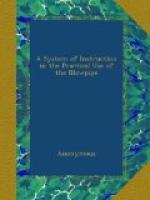(7.) Silica, Silicic Acid (SiO^{3}).—This acid exists in the greatest plenty, forming no inconsiderable portion of the solid part of this earth. It exists nearly pure in crystallized quartz, chalcedony, cornelian, flint, etc., the coloring ingredients of these minerals being generally iron or manganese.
With microcosmic salt, silica forms a bead in the flame of oxidation which, while hot, is clear, while the separated silica floats in it. A platinum wire is generally used for the purpose, the end of it being first dipped in the salt which is fused into a bead, after which the silica must be added, and then the bead submitted to the flame of oxidation.
The silicates dissolve in soda but partially, and then with effervescence. If the oxygen of the acid be twice that of the base, a clear bead will be obtained that will retain its transparency when cold. If the soda be added in small quantity, the bead will then be opaque. In the first instance, a part of the base which separates is re-dissolved, and, therefore, the transparency of the glass; but, if too large a quantity of the soda is added, the separation of the base is sufficient to render the assay infusible.
(8.) Chlorine (Cl).—Chlorine exists in nature always in combination, as the chlorides of sodium, potassium, calcium, ammonium, magnesia, silver, mercury, lead, copper, etc.
The chlorine existing in metallic chlorides may be detected as follows: the wet way may be accomplished in the following manner. If the substance is insoluble, it must be melted with soda to render it soluble; if it be already soluble it must be dissolved in pure water, and nitrate of silver added, when the one ten-thousandth part of chlorine will manifest its presence by imparting a milky hue to the fluid.
By the blowpipe, chlorine may be detected in the following manner: Oxide of copper is dissolved in microcosmic salt on the platinum wire in the flame of oxidation, and a clear bead is obtained. The substance containing the chlorine is now added, and heat is applied. The assay will soon be enveloped by a blue or purplish flame. As none of the acids that occur in the mineral kingdom give this reaction, chlorine cannot be confounded with them, for those which impart a color to the flame, when mixed with a copper salt, will not do so when tested in the microcosmic salt bead as above indicated.
If the assay is soluble in water, the following method may be followed: a small quantity of sulphate of copper or iron is dissolved; a few drops of the solution is placed upon a bright surface of silver, and the metallic chloride added; when, if chlorine is present, the silver is blackened. If the chloride is insoluble in water, it must be rendered soluble by fusion upon a platinum wire with soda, and then treated as above.[2]
[2] Plattner.




